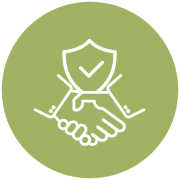(102-21, 102-40, 102-42)
During the year, we continued our efforts to protect the health, safety and well-being of our stakeholders through actions directed at each specific group. Dialogue with them has always been a part of our daily activities which has given us the reputation as a solid, reliable company. Fibra Danhos’ stakeholders are:

To protect our employees, we continued our work-from-home scheme through March of 2021 when we organized a hybrid return to the office, following strict safety protocols and official guidelines, mindful of recurring outbreaks of COVID-19. Remote working schemes necessitated a swift deployment of new digital skills and processes, as well as new forms of online collaboration and communication. All of our employees responded with a commendable spirit of commitment and responsibility, which was one reason we were successful in weathering this year of daunting challenges.
For our tenants, from the first quarter of the year we continued our policy of open dialogue and support, as mobility variables were affected by the partial closure of properties for almost half of the first quarter, and with limitations on opening hours and store capacity. As tenant and visitor traffic grew, however, economic activity became increasingly dynamic, vacancy levels dropped to minimum levels and the need for support programs lessened considerably from the previous year.

Even though our shopping centers remained open, footfall did not recover until the fourth quarter of the year. Throughout that time, we followed all the safety measures imposed by the authorities, like maintaining safe distances, offering sanitizing gel and taking the temperature of each visitor. Businesses that habitually attract more visitors—restaurants and entertainment—began returning to normal operations in the second quarter of the year.
We stayed in touch with our suppliers and communities primarily by e-mail, phone and videoconferencing. We supported tenants by placing tables and chairs in the corridors and open areas within our shopping centers, always prioritizing the health of our guests through proper social distancing and traffic restriction measures.
Each area of the company is responsible for bilateral communication with stakeholders, whose participation is necessary for various concrete actions—in the case of developers, for designing and building our properties—and to identify the needs and expectations of each of these.
During the year, we continued our efforts to protect the health, safety and well-being of our stakeholders through actions directed at each specific group.


In order to collect information on our stakeholders and stay abreast of their expectations, we continued to apply a questionnaire in all of our properties every two weeks. We also provided them transparent, responsible, timely and appropriate information through the following channels for communication and feedback:
(102-43, 413-1)
| Stakeholder group | Communication | Expectations | Frequency |
|---|---|---|---|
| Employees | Daily virtual meetings, company communiqués, institutional e-mail. | Knowing that the company is concerned about them, particularly in a year as complex as this one. |
|
| Tenants | Property management. Contract signing and renewal. |
Solidarity in this difficult year.Sustainable management of operations where they rent their locale. |
|
| Visitors | To ensure our visitors have an unforgettable experience in our properties, we actively seek their feedback in various ways. | Safety, satisfaction and a safe place to enjoy their visit. |
|
| Suppliers | Supply contracts. Annual reports. |
Maintain ethical, mutually beneficial relations. |
|
| Investors | In addition to quarterly and annual reports and the annual shareholders’ meetings, the investor relations team at Fibra Danhos meets with current and prospective investors on request, to answer any questions and to ask them for feedback. | Inform them of our business strategies, financing and use of proceed, even in crisis conditions, maintaining our sustainable business vision and model. |
|
| Communities and NGOs | Quarterly reports, Annual reports, Investor relations dept. | Have spaces that contribute value to communities by creating jobs and properties that restore zones and inject life, safety and economic resources to communities. |
|
| Government and industry relations | Continuous interaction to stay abreast of policies that may affect our properties, business model and investment activities.Through Amefibra (The Mexican FIBRAS Association), we deal with all types of issues that are internal and external to the industry. | Information on corporate governance and new policies. |
|
(201-4)
We also have a Stakeholder Engagement Policy that involves all employees of Fibra Danhos, supporting the connection with and value of each stakeholder for the company (https://api.fibradanhos.com.mx/static/policy/1_stakeholders_relations_policy_2022_en.pdf). This policy is complemented by the guidelines of our Code of Ethics (https://api.fibradanhos.com.mx/static/policy/3_code_of_ethics_2022_en.pdf).
Fibra Danhos does not make or receive contributions or assistance to or from the government.
Successful relations with our stakeholders are sustained by a series of principles and synergies between them; this means that we generate value for everyone, magnifying the positive impacts of the company’s activities, securing a financial return and contributing to socioeconomic development. These principles are the following:




